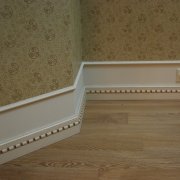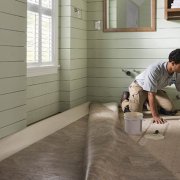How to insulate a floor with linoleum
There are 2 ways to make the floor warm by choosing linoleum as the floor covering. The construction team invited to the site will ask about preferences: install heating elements - a water, electric or infrared floor heating, or insulate the structure using a substrate. In order not to get confused, we suggest to figure out in advance how to insulate the floor with linoleum more reliable and easier. For owners of private houses, information on how to insulate a wooden floor under linoleum is more relevant. Residents of apartment buildings are more interested in what kind of insulation to put under the linoleum on the concrete floor. In this article we will provide useful information on how to insulate the floor with both bases under linoleum.
The content of the article
Is linoleum insulation necessary
It is permissible not to put insulation under linoleum on a wooden floor. Like concrete. This is done exclusively at the request of the owners. Manufacturers of flooring are constantly improving technology, so today we see linoleum in construction stores, which our parents could not imagine. We offer increased strength and wear resistance, exotic colors and patterns, special protective and insulation layers.
According to builders and finishers, even high-quality natural and multi-layer synthetic linoleum need insulation.
- Firstly, the insulation acts as an additional sound insulator.
- Secondly, the thermal insulation of the coating is insufficient so that in winter the feet do not freeze on the floor laid only with linoleum.
- Thirdly, it will save on heating - there are types of insulation used as the main way of heating a house; they allow you to feel comfortable indoors even in winter without warm socks.
It is logical to take care of this at the stage of repair, creating a new floor from scratch, especially if you install insulation with the help of heating elements.
But not all the owners are so far-sighted and the question arises whether it is possible to put insulation under the linoleum if the finishing work has already been completed and the linoleum is laid. It is possible, both in the case of a fresh repair, and years after. After all, if the floor has been laid for a long time, there are wooden boards at the base that have lost their original shape, and the thickness of the coating does not inspire confidence - this is an occasion to urgently warm the floor without waiting for repair.
Material selection
We will not dwell on the installation of water and electric underfloor heating. Installation of the necessary elements - in the first case, pipes act as insulation under the linoleum, in the second - insulation cables (involves a significant increase in the floor level). For domestic premises this is a significant loss, up to difficulties with opening and closing interior doors. We focus on the methods of floor insulation under linoleum, which will not create such difficulties. Choosing the right material, start from the method of insulation. This will be discussed in the following sections.
Briefly about linoleum itself
Linoleum is chosen by those who want to get a presentable and reliable flooring without paying too much. Classifications of linoleum are widespread by material (natural and artificial) and by scope of application (household, semi-commercial, commercial and special). Natural is a mixture of wood flour, resins and oils, and the main artificial (synthetic) material is polyvinyl chloride (PVC).Artificial linoleum is divided into homogeneous (single-layer) and heterogeneous (in which layers for different purposes are combined - including the lower one is designed to retain heat). Traditionally, residential and semi-commercial linoleum is used in residential premises, from natural raw materials or synthetic - it depends on the needs and budget of the owners. As mentioned earlier, it is necessary to insulate all of these types, but when choosing a heater for linoleum, we will take into account the type of coating.
What are the insulating linoleum substrates
In the narrow sense, warming substrates are understood to mean soft materials produced in rolls and rigid structures supplied in the form of plates. For full ownership of information, we will also talk about infrared film (although this is more likely to design a “warm floor” system) and liquid insulation - in some way, they also act as a substrate.
Natural floor insulation for linoleum includes cork and jute fabric, a substrate of linen or its mixture with wool and jute. How to insulate the floor with linoleum was taken care of not only by nature, but also by the chemical industry, offering for this purpose numerous polymers: ponepolisterol (penopleks), isolon (penofol), penoizol.
Substrates made from natural raw materials are more expensive, but environmentally friendly and it is soft and pleasant to walk on them. This is true for families with young children who often fall, but over time, cork and canvas will accumulate dust and may become the habitat for insects. When choosing such a heater for linoleum on a wooden floor or concrete base, remember also that their environmental friendliness will not lose its meaning only in combination with natural linoleum. Artificial linoleum will negate this advantage. In addition, the resistance to burning, decay and mold of natural fibers in any case is achieved by impregnation with certain synthetic compounds. Fiberboard is made of wooden fibers, so it is also referred to as natural insulation for the floor under linoleum. A feature of installation in case of use is mandatory waterproofing.
Insulation for the floor under linoleum from synthetic materials are available in various forms. Ponepolisterol (do not confuse its subspecies of penoplex with a trademark that differs by one letter - other companies also produce it) - this is a porous plate. Not recommended for indoor use due to the risk of harmful fumes. Isolon (penofol) is a polyethylene foam with a closed cellular structure, penoizol is a specialized foam without harmful fumes and not amenable to burning. Polymers are inexpensive, warmly insulated and act as a layer of sound insulation.
Liquid insulation (including insulation paint) is a composition that is applied with a layer of 1 mm. But to achieve such a layer thickness, a lot of composition will be required, but it is not so cheap, therefore this method cannot be called economical. Suitable if it is critically important not to raise the floor. Another option for this case is to insulate the floor under the linoleum with an infrared film, which also has a relatively small thickness.
Subtleties of installation of different types of insulation
If, when choosing a method of insulation, you decide to lay a warm floor - here you will probably need the help of professionals. But the installation of coil or tile insulation is much simpler, often the owners lay it on their own. Depending on the shape of the insulation, a different set of tools will come in handy.
Method 1: installing a soft coating
A soft coating is usually chosen as insulation under linoleum on a wooden floor. Mounting it is extremely simple, for this you will need scissors and adhesive mastic or tape. In some cases, sheets of thick plywood are also used - if the difference in floor height per square meter is more than half a centimeter.Plywood is attached to the floor with a punch and dowels, recessing the hats into sheets. Joints and screws are plastered and sanded. Particleboard for this purpose is not suitable because of the strong moisture permeability and the content of carcinogens. After examining the integrity of the original surface and thoroughly cleaning it, spread the cut pieces of the substrate butt-to-butt, without overlapping.
With smooth tape fasten together smooth types of substrates (cork or polymers), adhesive mastic will fix fibrous and fleecy - from jute, linen and wool. Moreover, it is not necessary to cover the floor surface under the substrate with a continuous layer of adhesive mastic, it is enough to glue the areas along the joints by a centimeter in each direction. This is enough for reliable fastening, significantly saves the glue consumption and simplifies dismantling if it is needed once. If you bought such insulation under linoleum on a concrete floor, and at the bottom of a basement or other source of dampness, it is worthwhile to apply waterproofing. Remember also: if one of the layers of insulation is foil, it will look inside the room to reflect heat.
Method 2: installation of a hard insulation
Here plywood is required in any case, regardless of differences in floor height. The fact is that polystyrene or polystyrene foam, traditionally used as a hard insulation on a wooden floor or on concrete, despite their strength, is inevitably sold by one point from strong pressure. This point will create every leg of furniture. To prevent this, a crate is installed on the insulation boards, the thickness of the bars corresponds to the thickness of the main insulation on the floor under the linoleum. We fasten the bars with the base with dowels, insert insulation sheets between them without gaps, tightly. It remains only to sew up plywood on top.
Conclusion
No matter what high-quality and high-tech linoleum you buy, an additional insulation for the floor under linoleum will still be needed. Before choosing, analyze the characteristics of the room: the integrity and evenness of the initial coating, at what height it is permissible to raise the floor, what linoleum is purchased, are you looking for insulation under linoleum on a wooden floor or on concrete. Calculate the cost of materials, fittings and installation in advance for each suitable method. Then, it will be possible to warm the wooden floor under linoleum or lay the insulation under linoleum on the concrete floor with the saving of effort and money.








